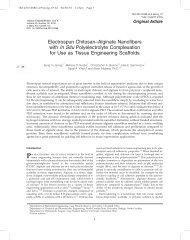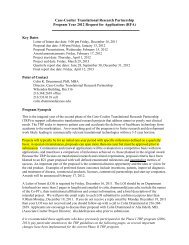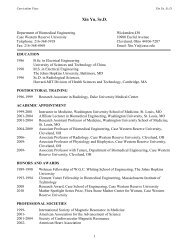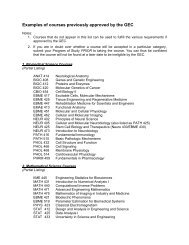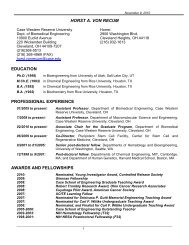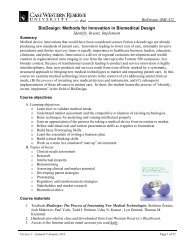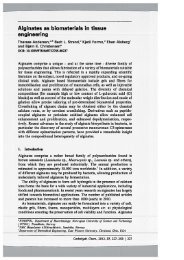Tissue-Engineered Spleen Protects Against Overwhelming ...
Tissue-Engineered Spleen Protects Against Overwhelming ...
Tissue-Engineered Spleen Protects Against Overwhelming ...
Create successful ePaper yourself
Turn your PDF publications into a flip-book with our unique Google optimized e-Paper software.
Journal of Surgical Research 149, 214–218 (2008)<br />
doi:10.1016/j.jss.2008.01.010<br />
<strong>Tissue</strong>-<strong>Engineered</strong> <strong>Spleen</strong> <strong>Protects</strong> <strong>Against</strong> <strong>Overwhelming</strong><br />
Pneumococcal Sepsis in a Rodent Model<br />
Tracy C. Grikscheit, M.D.,* ,1 Frédéric G. Sala, Ph.D.,* Jennifer Ogilvie, M.D.,† Kate A. Bower, M.D.,‡<br />
Erin R. Ochoa, M.D.,§ Eben Alsberg, Ph.D., ¶ David Mooney, Ph.D.,� and Joseph P. Vacanti, M.D.€<br />
*Department of Surgery and Saban Research Institute, Children’s Hospital Los Angeles, Los Angeles, California; †Department of Surgery,<br />
University of Pittsburgh Medical Center, Pittsburgh, Pennsylvania; ‡Department of Pediatrics, C. S. Mott’s Children’s Hospital, Ann<br />
Arbor, Michigan; §Department of Pathology, University of Pittsburgh Medical Center, Pittsburgh, Pennsylvania; ¶ Departments of<br />
Biomedical Engineering and Orthopaedic Surgery, Case Western Reserve University, Cleveland, Ohio; �Department of Engineering and<br />
Applied Science, Harvard University, Boston, Massachusetts; €Department of Surgery, MassGeneral Hospital for Children,<br />
Boston, Massachusetts<br />
Background/Purpose. Solid organs production is an<br />
ultimate goal of tissue engineering. After refining a<br />
technique for intestinal engineering, we applied it to<br />
a solid organ, the spleen. <strong>Overwhelming</strong> postsplenectomy<br />
sepsis results in death in nearly half of all<br />
cases. This risk is pronounced in children. Necrosis<br />
of autotransplanted spleen slices occurs prior to regeneration.<br />
We postulate that tissue engineering<br />
techniques might be superior.<br />
Methods. Four groups of Lewis rats were compared:<br />
sham laparotomy, tissue-engineered spleen (TES), traditional<br />
spleen slices, and splenectomy. TES was generated<br />
from splenic units, multicellular components of<br />
juvenile spleen implanted on a biodegradable polymer<br />
scaffold, and spleen slices were derived from agematched<br />
juveniles. Pneumococcal sepsis was induced<br />
at wk 16, and survival curves were constructed.<br />
Results. <strong>Tissue</strong>-engineered spleen protected against<br />
pneumococcal septicemia with a survival proportion<br />
of 85.7% compared with 41.17% of splenectomized animals.<br />
<strong>Spleen</strong> slice was also protective with 71.43% survival.<br />
Compared with splenectomy, control and TES<br />
groups were statistically significant (P � 0.0002, P �<br />
0.0087; hazard ratio of splenectomy � 5.493) and the<br />
Slice group was nearly statistically significant (P �<br />
0.0642, hazard ratio of splenectomy � 2.673).<br />
Conclusions. TES is a novel application of tissue engineering<br />
to splenic regeneration and creates a func-<br />
1 To whom correspondence and reprint requests should be addressed<br />
at Department of Surgery and Saban Research Institute,<br />
Childrens’ Hospital Los Angeles, 4650 Sunset Boulevard Mailstop<br />
#100, Los Angeles, CA 90027. E-mail: tgrikscheit@chla.usc.edu.<br />
0022-4804/08 $34.00<br />
© 2008 Elsevier Inc. All rights reserved.<br />
Submitted for publication July 12, 2007<br />
214<br />
tional spleen. This approach could be advantageous in<br />
severe pediatric trauma. © 2008 Elsevier Inc. All rights reserved.<br />
Key Words: tissue engineering; tissue-engineered intestine;<br />
tissue-engineered spleen; solid organ tissue<br />
engineering; overwhelming postsplenectomy sepsis;<br />
pneumococcal sepsis.<br />
INTRODUCTION<br />
Death results from overwhelming postsplenectomy<br />
sepsis in greater than half of all cases [1–5]. This high<br />
risk of mortality is pronounced in children, and despite<br />
modern vaccines and critical care, lack of splenic function<br />
in children is also associated with decreased<br />
quality-adjusted life expectancy [6, 7]. Altered opsonic<br />
function, decreased serum IgM, decreased response to<br />
antigen challenge, and less complement, T lymphocytes,<br />
tuftsin, and properdin are observed [4]. The<br />
spleen’s ability to regenerate has been known as useful<br />
since Griffin and Tizzoni’s appreciation of this capacity<br />
in 1883. They first observed splenosis, as named by<br />
Buchbinder and Lipkoff in 1939, in the peritoneum of<br />
splenectomized dogs [8, 9].<br />
The histological regeneration of the spleen from fragments<br />
implanted either subcutaneously or intraperitoneally<br />
has been documented to occur with an initial<br />
necrosis of the tissue down to a rudimentary connective<br />
tissue structure with hypocellularity and a loss of lymphoid<br />
elements [10–12]. This is followed by repopulation<br />
of the connective tissue structure, regrowth of<br />
blood vessels, and eventual regeneration of red and<br />
white pulp by 5 to 7 wk [10–12]. Regeneration of spleen<br />
in the peritoneum has been favorable over other sites,
GRIKSCHEIT ET AL.: TISSUE-ENGINEERED SPLEEN PROTECTS<br />
and the omentum has been favored for the possibility of<br />
venous portal circulation for hepatic participation in<br />
antigen processing [13]. Experimental studies of the<br />
protective effect of various techniques (homogenized<br />
spleen, thin or thick slices, grated tissue, diverse<br />
cubes) of splenic autotransplantation have yielded a<br />
protective effect from splenic regeneration [10]. The<br />
most common model used to test regenerated splenic<br />
function is the omental pouch. This model was first<br />
shown to be protective in Sprague Dawley rats challenged<br />
by pneumococcal peritonitis [14].<br />
In the case of the spleen slice, successful regeneration<br />
occurs on the rudimentary connective tissue scaffold<br />
that results from major necrosis [10–12]. Wehypothesized<br />
that supplying a splenic construct ready to<br />
supply a proxy for this scaffold might result in more<br />
successful splenic regeneration from a greater number<br />
of viable cells and, therefore, could be protective. We<br />
proposed to supply the connective tissue framework in<br />
the form of a biodegradable polymer and the regenerative<br />
cells in the form of splenic units (SU), multicellular<br />
splenic aggregates sized to survive on a the polymer<br />
by imbibition prior to vascular ingrowth.<br />
We first reported making tissue-engineered small<br />
intestine by the transplantation of organoid units on a<br />
polymer scaffold into the omentum of the Lewis rat<br />
[15]. Organoid units are multicellular units derived<br />
from neonatal rat intestine containing a mesenchymal<br />
core surrounded by a polarized intestinal epithelium,<br />
and contain all of the cells of a full-thickness intestinal<br />
section [16]. This protocol has been significantly transformed<br />
to yield greater numbers of organoid units more<br />
efficiently from an additional area of the gastrointestinal<br />
tract, the sigmoid colon. The protocol changes lead<br />
to some evidence of increased viability, as production of<br />
tissue-engineered colon (TEC) occurs 100% of the time<br />
[17]. In addition, there is some initial evidence of in<br />
vivo physiological replication of major functions by the<br />
TEC, which produces short-chain fatty acids and absorbs<br />
moisture and sodium compared with animals<br />
that lack TEC [17]. In the case of TEC, the model in<br />
which much of the protocol refinement was done, the<br />
histology was indistinguishable from native colon with<br />
an appropriate epithelial layer, actin-positive muscularis<br />
propria containing S100 positive cells in the distribution<br />
of Meissner and Auerbach’s plexi as well as<br />
lucent adjacent ganglion cells [18].<br />
<strong>Tissue</strong>-engineered small intestine generated in this<br />
fashion has markedly improved tissue architecture including<br />
ganglion cells and a mucosal immune system<br />
with an immunocyte population similar to that of native<br />
small intestine [19]. When used as a “rescue” following<br />
massive small bowel resection, Lewis rats with<br />
tissue-engineered small intestine regain weight at a<br />
more rapid rate up to their preoperative weights, while<br />
animals without the engineered intestine fail to thrive<br />
[20]. The “rescued” animals also had normal serum<br />
levels of B12 while those in the control group were<br />
subnormal. <strong>Tissue</strong>-engineered esophagus has also<br />
been generated and successfully used in a replacement<br />
model with this approach [21].<br />
We hypothesized that these techniques could be<br />
translated to the production of a functional, solid organ,<br />
tissue-engineered spleen (TES) that could be used<br />
in replacement in a juvenile model.<br />
Solid organ tissue engineering in vivo has been severely<br />
limited by the problem of the large metabolic<br />
demand of compact cells as the radius expands. Oxygen<br />
diffusion only allows a few hundred �m of tissue to be<br />
supported before the oxygen is consumed, and this has<br />
been a major design constraint for solid organs [22].<br />
Because tissue-engineered intestine is a hollow viscus<br />
organ with less tissue density that must be supported<br />
while angiogenesis and vasculogenesis occur in parallel,<br />
it can be generated with the strategy of scaffold<br />
implantation into a vascularized space. The quantity of<br />
engineered intestine produced by our improved protocols<br />
has become so much larger as a result of faster<br />
processing and presumably less cellular insult that we<br />
hypothesized that some solid organs could be produced<br />
by this method.<br />
Understanding the mechanisms that support this<br />
growth of solid organs in vivo after tissue processing<br />
could help to identify the regenerative pathways that<br />
support tissue growth in both these models and in vivo<br />
after injury or during organogenesis.<br />
MATERIALS AND METHODS<br />
<strong>Spleen</strong>—Four Surgical Groups<br />
Animals were cared for in compliance with the Institute of Laboratory<br />
Animal Resources Guide. Sixty-eight male 150 g Lewis rats<br />
were divided into four groups of 17 animals each: Control, Splenectomy,<br />
<strong>Spleen</strong> Slice, and TES. The animals were housed under normal<br />
laboratory conditions with free access to food and water.<br />
Specific surgeries were carried out contemporaneously. Control<br />
rats underwent sham laparotomy. Splenectomy rats underwent splenectomy<br />
through a midline incision. <strong>Spleen</strong> Slice animals underwent<br />
splenectomy and implantation of two 3 mm slices of spleen next to<br />
each other in the manner of Patel et al., [14] but derived from<br />
syngeneic 6-d old rat pups into an omental pouch sutured with one<br />
6-0 Prolene at the point where all flaps of omentum overlay each<br />
other like an envelope. TES Animals underwent implantation of the<br />
TES construct, a biodegradable polymer loaded with syngeneic SU in<br />
the same fashion in the omentum.<br />
Generating TES from SU<br />
215<br />
SU were produced by dissecting the spleens from 6-d-old Lewis rat<br />
pups (n � 20). The resected specimens were washed two times in 4°C<br />
Hank’s balanced salt solution, sedimenting between washes, and<br />
digested with dispase 0.25 mg/mL (Boehringer Ingelheim, Ingelheim,<br />
Germany) and collagenase Type 1 (Worthington, Lakewood,<br />
NJ) 800 U/mL on an orbital shaker at 37°C for 18 min. The digestion<br />
was immediately stopped with three 4°C washes of a solution of high<br />
glucose Dulbecco’s modified Eagle’s medium, 4% heat-inactivated fetal<br />
bovine serum, and 4% sorbitol. The SU were centrifuged between
216 JOURNAL OF SURGICAL RESEARCH: VOL. 149, NO. 2, OCTOBER 2008<br />
FIG. 1. Gross examination of tissue-engineered spleen (TES)<br />
compared with native spleen at 8 wk in a rat that did not undergo<br />
splenectomy at construct implantation.<br />
washes at 150 g for 5 min, and the supernatant removed. SU were<br />
reconstituted in high glucose Dulbecco’s modified Eagle’s medium with<br />
10% inactivated fetal bovine serum, counted by hemocytometer, and<br />
loaded, 100,000 units per polymer at 4°C, and maintained at that<br />
temperature until implantation, which occurred in less than 1.5 h.<br />
Polymer Design<br />
Scaffold polymers were constructed of 2 mm thick nonwoven<br />
polyglycolic acid (fiber diameter: 15 �m; mesh thickness: 2 mm; bulk<br />
density: 60 mg/cm 3 ; porosity: � 95%) (Smith and Nephew, Heslington,<br />
York, United Kingdom), formed into 1 cm tubes (o.d. � 0.5 cm, i.d. � 0.2<br />
cm), and sealed with 5% poly-L-lactic acid (Sigma-Aldrich, St. Louis,<br />
MO) in chloroform. Polymer tubes were sterilized in 100% ethanol at<br />
room temperature for 20 min, then washed with 500 mL of phosphatebuffered<br />
saline (PBS), coated with 1:100 collagen Type1:PBS solution<br />
for 20 min at 4°C, and washed again with 500 mL PBS. Polymer tubes<br />
were internally loaded with splenic units by micropipette.<br />
Pneumococcal Infection<br />
Sixteen wk after operation, three animals in the spleen slice and<br />
three animals in the TES groups had died. All of these deaths<br />
occurred within 1doftheinitial surgery. Necropsy did not reveal<br />
surgical error or infection, making anesthesia or aspiration likely<br />
candidates. The remaining animals were healthy and weighed 425 to<br />
470 g. Streptococcus pneumoniae type 25 (ATCC) was maintained on<br />
soy trypticase agar plates, and grown up overnight in brain-heart<br />
infusion broth. Serial dilution experiments were carried out to determine<br />
the absorbance and growing conditions that corresponded to<br />
1 � 10 7 CFU. This amount was diluted in 2 cc PBS and injected<br />
intraperitoneally in each rat at time 0. Animals were observed every<br />
12 h for the next 21 d. Necropsy was performed on all animals that<br />
succumbed, and blood smears were obtained as well as tissue to<br />
confirm bacterial sepsis. At d 21 all animals were humanely euthanized<br />
and their tissues collected. In addition to hematoxylin and eosin<br />
(H&E) histology, immunohistochemistry for von Willebrand factor and<br />
CD3 was performed as were DNA assays. Survival curves were generated<br />
with the equivalent of the Mantel-Haenszel logrank test excluding<br />
the postoperative deaths at the beginning of the experiment.<br />
TES Study Groups<br />
To further characterize TES, the construct was implanted in 8 additional<br />
rats with (TES�, n � 8) or without splenectomy (TES�, n � 8).<br />
Constructs were harvested at wk 2, 3, and 8, analyzed by H&E, immunohistochemistry,<br />
dry weight, and DNA assay. Statistics were performed<br />
by Mann-Whitney and analysis of variance, reported �/� SEM.<br />
RESULTS<br />
By 2 mo all animals implanted with TES generated<br />
visible deep purple TES (Fig. 1) from SU histology<br />
revealed organized spleen parenchyma (Fig. 2) with<br />
white pulp lacking germinal centers organized around<br />
arteries that stain for von Willebrand Factor (Fig. 3)<br />
and red pulp with venous sinuses. Immunohistochemical<br />
staining for the antigen CD3 was detected in the<br />
interfollicular zone (data not shown). In early TES (wk<br />
2 and 3), there was developing splenic architecture<br />
without evidence of necrosis. Pitted erythrocytes were<br />
seen on blood smear at 16 wk. The harvested TES was<br />
approximately twice the size of the spleen slice (Fig. 4).<br />
No animal in the Splenectomy group had evidence of<br />
splenosis at necropsy. The polymer was completely<br />
resorbed in the TES animals, as shown by the lack of<br />
refractive polymer seen on histology and on gross inspection.<br />
Animals implanted with the spleen slices also generated<br />
organized splenic parenchyma (Fig. 5) and had<br />
pitted erythrocytes on blood smear at 16 wk. Survival<br />
proportions varied following inoculation with S. Pneumoniae<br />
(Fig. 6). Control animals (100%) were followed<br />
by TES (85.7%, death on d 3 and 4), <strong>Spleen</strong> Slice<br />
(71.43%, d2to4)andSplenectomy (41.17%, d1to4).<br />
Compared to Splenectomy, Control and TES groups<br />
were statistically significant (P � 0.0002, P � 0.0087;<br />
hazard ratio of splenectomy � 5.493) and the Slice<br />
FIG. 2. H&E TES at 16 wk, original magnification.
GRIKSCHEIT ET AL.: TISSUE-ENGINEERED SPLEEN PROTECTS<br />
FIG. 3. TES (A) and native spleen (B) stain for immunohistochemical detection of the antigen von Willebrand Factor in central arterioles,<br />
original magnification 10�.<br />
group was nearly statistically significant (P � 0.0642,<br />
hazard ratio of splenectomy � 2.673). DNA assays of<br />
the preimplant TES construct and the preimplant<br />
spleen slices were not statistically different significantly<br />
in ng DNA/mg dry weight. DNA content of the<br />
harvested TES, TES without splenectomy, spleen slice,<br />
and native spleen were not significantly different, at<br />
7.836, 9.456, 8.764, and 8.223 ng DNA/mg dry weight.<br />
DISCUSSION<br />
This is the first report of the use of tissue engineering<br />
techniques to replace the juvenile spleen<br />
after splenectomy. The omental implantation of the<br />
TES protected against pneumococcal septicemia<br />
with a survival proportion of 85.7% compared with<br />
41.17% of splenectomized animals. <strong>Spleen</strong> slice was<br />
also protective with 71.43% survival. The sequence of<br />
deaths in this study was different from previous studies<br />
[14] in which the spleen slice deaths have been later<br />
than the deaths of splenectomized animals. In addition,<br />
pitted erythrocytes persisted in all groups except<br />
the controls. The hazard ratio of splenectomy compared<br />
with TES (5.493) was nearly double that of<br />
spleen slice (2.673), with larger volumes of splenic tis-<br />
FIG. 4. Gross examination of TES (A) and spleen slice (B) at<br />
16 wk.<br />
217<br />
sue harvested from TES animals. Size of splenic implants<br />
has not been definitively correlated with function,<br />
and critical splenic mass therefore remains<br />
theoretical [10].<br />
We report this finding as a model in which to pursue<br />
the pathways that allow solid organs to regenerate,<br />
and in the case of the tissue-engineered spleen, to<br />
function appropriately. Twenty years ago, in the earliest<br />
investigations of a similar technique by the senior<br />
author, selective cell transplantation using a bioabsorbable<br />
artificial polymer as a matrix resulted in<br />
three of 66 matrixes seeded with hepatocytes showing<br />
viable hepatocytes, and no pancreatic cells survived<br />
implantation [23]. In 23 implantations of intestinal<br />
cells, there were three cases of engraftment, and one 6<br />
mm cyst formed [23]. <strong>Tissue</strong>-engineered intestine has<br />
now progressed in the rodent model to usable quantities<br />
that function in replacement models with high<br />
fidelity, and the specificity of each portion of the gastrointestinal<br />
tract. A similar rate of progress with solid<br />
organs would be clinically important.<br />
FIG. 5. H&E spleen slice at 16 wk, original magnification 4�.
218 JOURNAL OF SURGICAL RESEARCH: VOL. 149, NO. 2, OCTOBER 2008<br />
FIG. 6. Survival proportions of Control, TES, <strong>Spleen</strong> Slice, and<br />
Splenectomy groups over 21 d after pneumococcal infection.<br />
Direct comparison of TES and spleen slice techniques<br />
requires further study of specific immune function.<br />
However, it can be unequivocally stated that the<br />
formation of TES is a successful novel strategy for<br />
producing functional spleen, and in the case of severe<br />
pediatric trauma, it could be an attractive strategy for<br />
the preservation of splenic mass. Early authors reported<br />
the failure of splenosis when the native spleen<br />
is present, but as shown in Fig. 1, TES grew under<br />
these conditions. It may be advantageous to avoid the<br />
primary phase of almost complete necrosis that occurs<br />
after transplant of a spleen slice.<br />
Uniform processing and a biodegradable reticular<br />
framework produces greater splenic mass with appropriate<br />
splenic architecture and function. This report of<br />
successful engineering of a functional solid organ<br />
through cellular transplantation on a biodegradable<br />
scaffold indicates an exciting future direction. The next<br />
step forward would be a careful dissection of the mechanism<br />
of this solid organ tissue formation. The steps<br />
that occur from seeding to development of the engineered<br />
construct have not been evaluated, especially<br />
with reference to the necessary contributions of the<br />
donor and the host.<br />
ACKNOWLEDGMENTS<br />
This study was funded by the Center for the Integration of Medicine<br />
and Innovation in Technology, Department of Defense<br />
DAMDIT-99-2-9001.<br />
REFERENCES<br />
1. Singer DB. Postsplenectomy sepsis. In: Rosenberg HS, Bolande<br />
RP, Eds. Perspectives in Pediatric Pathology. Chicago: Yearbook<br />
Medical Publishers, Inc., 1973:285.<br />
2. Shaw JH, Print CG. Postsplenectomy sepsis. Br J Surg 1989;<br />
76:1074.<br />
3. Green JB, Shackford SR, Sise MJ, et al. Late septic complications<br />
in adults following splenectomy for trauma: A prospective<br />
analysis in 144 patients. J Trauma 1986;26:999.<br />
4. Krivit W, Giebink GS, Leonard AS. <strong>Overwhelming</strong> postsplenectomy<br />
infection. Surg Clin North Am 1979;59:223.<br />
5. Leonard AS, Giebink GS, Basel JJ, et al. The overwhelming<br />
postsplenectomy sepsis problem. World J Surg 1980;4:423.<br />
6. Velanovich V, Tapper D. Decision analysis in children with<br />
blunt splenic trauma: The effects of observation, splenorrhaphy,<br />
or splenectomy on quality-adjusted life expectancy. J Ped<br />
Surg 1993;28:179.<br />
7. Culligford GK, Watkins DN, Watts ADJ, et al. Severe late<br />
postsplenectomy infection. Br J Surg 1991;78:716.<br />
8. Griffini L, Tizzoni G. Etude expérimentale sur la réproduction<br />
partielle de la rate. Arch Ital Biol 1883;4:303.<br />
9. Buchbinder JH, Lipkoff CJ. Splenosis: Multiple peritoneal<br />
splenic implants following abdominal injury. A report of a case<br />
and review of the literature. Surgery 1939;6:927.<br />
10. Holdsworth RJ. Regeneration of the spleen and splenic autotransplantation.<br />
Br J Surg 1991;78:270.<br />
11. Gagnon RF, MacLennan ICM. Immune transfer using spleen<br />
fragments. J Clin Lab Immunol 1982;9:7.<br />
12. Tavassoli M, Ratzam RJ, Crosby WH. Studies on regeneration<br />
of heterotopic splenic autotransplants. Blood 1973;41:701.<br />
13. Vega A, Howell C, Krasna I, et al. Splenic autotransplantation:<br />
optimal functional factors. J Pediatr Surg 1981;16:898.<br />
14. Patel J, Williams JS, Naim JO, et al. Protection against pneumococcal<br />
sepsis in splenectomized rats by implantation of<br />
splenic tissue into an omental pouch. Surgery 1982;91:638.<br />
15. Choi RS, Vacanti JP. Preliminary studies of tissue-engineered<br />
intestine using isolated epithelial organoid units on tubular<br />
synthetic biodegradable scaffolds. Trans Proc 1997;29:848.<br />
16. Evans GS, Flint N, Somers AS, et al. The development of a<br />
method for the preparation of rat intestinal epithelial cell primary<br />
cultures. J Cell Sci 1992;101:219.<br />
17. Grikscheit TC, Ogilvie JB, Ochoa ER, et al. <strong>Tissue</strong>-engineered<br />
colon functions in vivo. Surgery Aug 2002;132:200.<br />
18. Grikscheit T, Ochoa ER, Ramsanahie A, et al. <strong>Tissue</strong>-engineered<br />
large intestine resembles native colon with appropriate in vitro<br />
physiology and architecture. Ann Surg 2003;238:35.<br />
19. Perez A, Grikscheit TC, Blumberg RS, et al. <strong>Tissue</strong>-engineered<br />
small intestine: Ontogeny of the immune system. Transplantation<br />
2002;74:619.<br />
20. Grikscheit TC, Siddique A, Ochoa ER, et al. <strong>Tissue</strong>-engineered<br />
small intestine improves recovery after massive small bowel<br />
resection. Ann Surg 2004;240:748.<br />
21. Grikscheit T, Ochoa ER, Srinivasan A, et al. <strong>Tissue</strong>-engineered<br />
esophagus: Experimental substitution by onlay patch or interposition.<br />
J Thorac Cardiovasc Surg 2003;126:537.<br />
22. Griffith LG, Naughton G. <strong>Tissue</strong> engineering—current challenges<br />
and expanding opportunities. Science 2002;295:1009.<br />
23. Vacanti JP, Morse MA, Salteman WM, et al. Selective cell<br />
transplantation using bioabsorbable artificial polymers as matrices.<br />
1988;23:(1 Pt 2):3.




